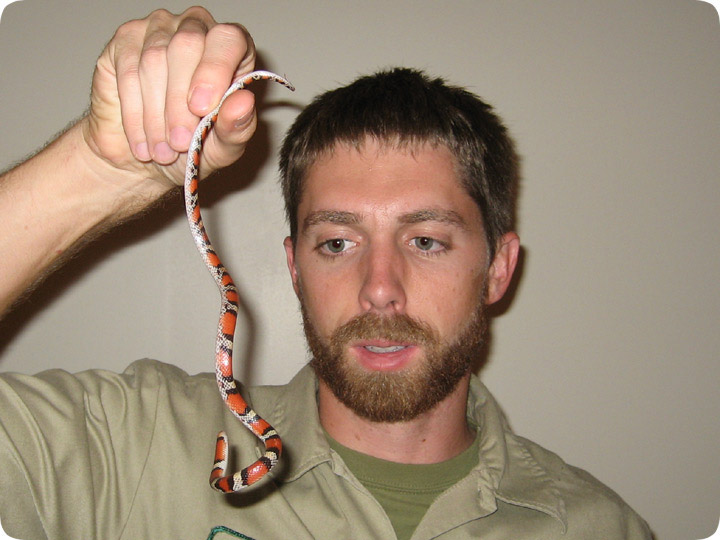-
info@aaanimalcontrol.com
Call us for help in your town
Humane Wildlife Education
Florida Scarlet Snake

This particular snake had an obnoxious defensive tactic (if you can call it that) of twisting, twisting, twisting. It never stopped twisting. I had to take about 40 photos of it in order to get a few in which it wasn't all twisted up. I don't mean knotted up in a ball, I mean constantly twisting like a corkscrew. I don't know the strategy behind this tactic, but I will say that a friend of mine, as a child, would spin around when he felt frustrated or threatened, and he seems to think that it worked. So I suppose there's something to this strategy. Regardless, I found it annoying, and I was glad to release the snake and watch it corkscrew its way off to freedom. Anyway, if you find one of these snakes, realize that it's harmless, beautiful, possibly rare, and please don't kill it.
Do it yourself: Visit my How To Get Rid of Snakes page for tips and advice.
Get professional help: Visit my Nationwide Pro Directory of wildlife removal experts.
For more wildlife stories, click my Wildlife Blog or click my below banner to hire a local trapper.

You can also catch snakes with a special trap, which you can order by clicking this banner:

Florida scarlet snake - The Florida scarlet snake is a relatively small, non-venomous snake found in North America. They are usually light in color with scarlet and red markings down their length. They are not the synonymous with scarlet king snakes. These serpents prefer to be active at night, feeding on other snakes and small animals. They commonly spend the daylight hours beneath fallen logs or piles of leaves. When it is time to breed, the scarlet snake will lay 3-8 eggs, and the group will usually hatch in the fall. Like all reptiles, the infant scarlet snakes receive no guidance or nurturing from their mother; they are immediately on their own. While three subspecies of scarlet snakes exist, the Florida scarlet snake can only be found on the Florida peninsula. Nuisance issues with Florida scarlet snakes are rare due to the animal’s inclination to be active at night. When captured, they will continually squirm until their attacker gets frustrated and will then let go. This is not always a practical method, but it may prove effective against birds or other animals that might lose a grip on such a wiggly creature.
The Florida scarlet snake, just one of the many snakes encountered in Florida, is among one of the few non-venomous snakes. If you’re living in Florida, it’ll calm you to know that this snake is non-venomous. As well, it’s quite an uncommon one to see, so you won’t have the headache of having one cross you as well. One of these can easily be confused for the Florida coral snake though, which IS poisonous, so it can pay well to recognize the difference between the two. A small distinction between the two is that the scarlet snake has more placid colors, but this isn’t easy to determine. The scarlet snake is one of the best-looking snakes too, which can make them favorable to see, looking not unlike a candy cane. You can remember if a snake is poisonous by the nursery rhyme, ‘red touch yellow, kill a fellow, red touch black, friend of Jack’. As the red pattern touches the black coloring, it’s non-poisonous. The same rings true for the cottonmouth, which is also non-poisonous, and the coral snake, which is. As multiple snakes follow the same pattern, this can be very confusing, but if you remember the pattern, it could help to save your life. The scarlet king and the red rat snake also follows similar patterns! It’ll calm you to know that this snake doesn’t need to be killed, despite what you may think if you run into one. Simply leave them be, and move away from them without provoking them. They won’t attack by default, as they’re only small animals that tend to mind their own business. However, if untrained, don’t try to move one of them yourself. You’re better safe than sorry.
Habitat
Because of the snakes secretive and uncommon nature, they spend nearly all of their downtime hiding away from their own predators. This can be under hardwood hammocks, logs, rocks, and other discrete and often shaded areas. They are seen most after rain and tend to like coming out after the sun has gone down when they’re less visible. You can find them in many of the southern states, as well as Florida.
Biology and Behavior
The snake's body can vary in color, but most commonly seen in this type of snake is a body of red blotches on its back, with black borders. In between the back, there are white bands, which helps in the identifying rhyme of whether it’s poisonous or not. They grow to an average of 20 inches long, although the recorded maximum is 32 inches. This snake enjoys burrowing into and hiding under leaf litter or multiple spaces which provide a lot of cover. They visit agricultural areas often, including open forested areas. They can swallow entire reptile eggs, and consume the contents. Although they are afraid or undisturbed by humans, if provoked over and over, they won’t be afraid to attack, much like most other snakes.
Additional Information
The Florida scarlet snake eats lizards, other snakes, reptile eggs, and rodents, depending on what’s available to them at their location. They are at their most reproductive in the early spring, and eggs are more likely to hatch in the summer or fall. Typically, a range from 3 to 8 eggs is laid each reproductive cycle, so one snake can make many more in its lifetime.




















